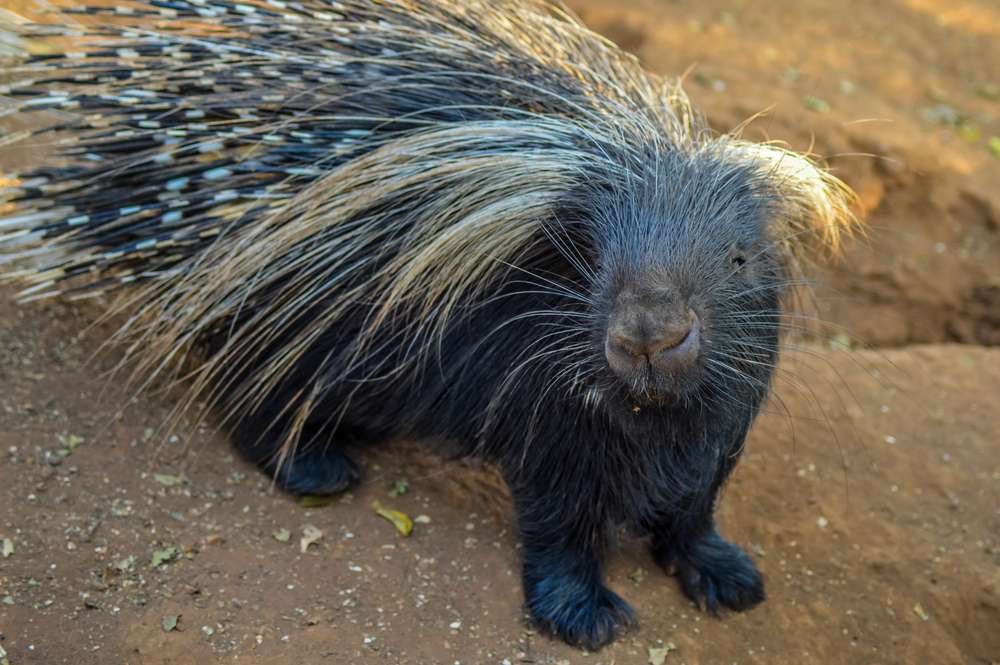Cape Porcupine
( South African porcupine )
- Hystrix africaeaustralis
- IUCN Status: Least Concern
- Trend: decreasing

- Kingdom: Animalia
- Phylum: Chordata
- Class: Mammalia
- Order: Rodentia
- Family: Hystricidae
- Genus: Hystrix
Share:
General Information
Cape porcupines are the largest rodents in Zambia.
Fun Facts!
Cape porcupines are excellent climbers and have been known to climb trees and shrubs to escape predators. They are also good swimmers and can often be found swimming in rivers and lakes.
Cape porcupines have a very good sense of smell and can detect predators from a great distance. When threatened, Cape porcupines will erect their quills and back towards their attacker. They may also charge at their attacker, or swing their tail to try to embed their quills in their attacker’s skin.
Description
- Length: up to 100 cm
- Weight: up to 40 kg
- Lifespan: up to 10yrs in the wild and up to 20yrs in captivity
Ecology and Behaviour
As do most well-armed or poisonous animals, the porcupine warns potential enemies of its defense system. When alarmed it will stamp its feet, click its teeth and growl or hiss while vibrating specialized quills that produce a characteristic rattle. The “rattle quills” on the end of the tail are hollow and open at the end so they produce the most noise. If an enemy persists, the porcupine runs backward until it rams its attacker. The reverse charge is most effective because the hindquarters are the most heavily armed and the quills are directed to the rear.
The porcupine is capable of putting on a very aggressive display, but it is basically timid. It is occasionally the target of predators such as pythons and leopards, sometimes to the detriment of the predator, which can die from quill wounds. Predators have been found dead with a porcupine lodged in their throat. Large owls also prey on young porcupines.
Conservation
Cape porcupines are listed as Least Concern on the IUCN Red List of Threatened Species. However, their populations are declining in some areas and they are vulnerable to habitat loss and hunting.
Distribution and Habitat
Cape porcupines are found across the whole of southern and central Africa. They eat mostly plant material: fruits, roots, tubers, bulbs, and bark. Cape porcupines are nocturnal and monogamous, typically living as mated pairs of adults, caring for any young together. Each pair may inhabit up to six burrows, jointly defending their shared territory, although they typically forage as individuals. Both sexes scent mark their territory, although males do so more frequently, and may play a more active role in its defense. The size of the home range varies depending on the local habitat and availability of food, but can range between at least 67 and 203 hectares (170 and 500 acres).
Natural shelters such as caves or crevices among roots and rocks are modified by porcupines to suit their needs. They will inhabit holes made by other animals but also dig their own. When these burrows have been occupied over several years, they will have several passages, entrances and exits.
Cape porcupines mate throughout the year, although births are most common during the rainy season, between August and March. Unless a previous litter is lost, females typically give birth only once each year.
Gestation lasts around 94 days, and results in the birth of a litter of up to three young, although over half of births are of singletons.
Relative to most other rodents, Cape porcupines are long-lived, surviving for ten years in the wild, or up to twenty years in captivity.
Interaction with humans
They are often considered pests by local farmers, because they can feed on crops and damage trees. However, their debarking of trees may also play a role in the maintenance of local savannah ecosystems, helping to prevent the development of denser forested environments.
Cape porcupines are an important part of Zambian culture and folklore. They are often featured in stories and myths, and are sometimes considered to be sacred animals.
No donation to this project yet.
| M | T | W | T | F | S | S |
|---|---|---|---|---|---|---|
| 1 | 2 | 3 | 4 | 5 | 6 | 7 |
| 8 | 9 | 10 | 11 | 12 | 13 | 14 |
| 15 | 16 | 17 | 18 | 19 | 20 | 21 |
| 22 | 23 | 24 | 25 | 26 | 27 | 28 |
| 29 | 30 | 31 | ||||


